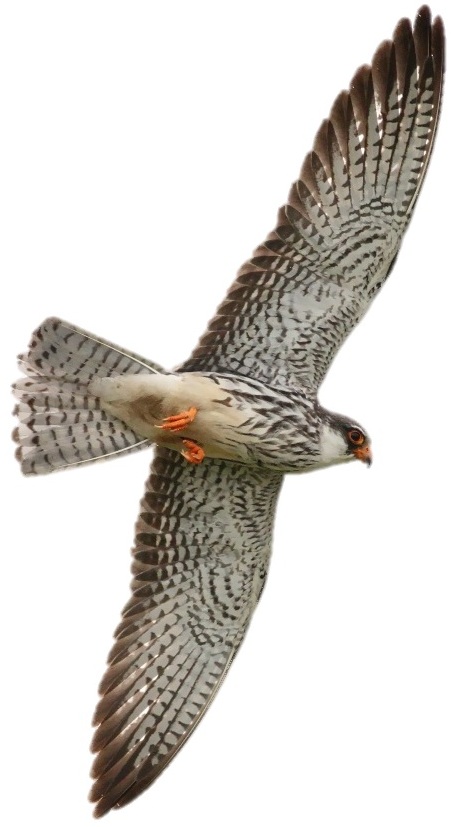Falco amurensis
In autumn, the Amur falcon takes wing in far eastern Asia to embark on a 22 000 km journey, where it will skirt the Himalayas, cross the Indian Ocean and travel through all of East Africa.
Male and female Amur falcon
Description
The Amur falcon (Falco amurensis) is an average size falcon, with a wing span of 63–71 cm and weighing about 120 g. The male and female are distinctly different. The male is a dark, sooty grey, with brownish-red thighs and vent. When flying, a white lining of the male’s wings stands out against the sooty grey. The female has a pattern common among many falcon species, with a dark spotted chest and vent against a white background, and a darker, grey back. A distinctive feature of both the male and the female is the orange of the eye-ring, beak base (the cere) and feet. As in many birds of prey, the male is smaller than the female, and usually weighs about 97-155 g whereas the female weighs about 110-188 g.
Ecology
A roost tree in NE India. photo: Ramki Sreenivasan
The Amur falcon is one of few birds of prey that are quite social. Even though many species of raptor can be seen flocking occasionally, for example during passage or at a site of a certain food resource, Amur falcons also seem to breed, migrate and roost together. Most accounts that describe its migration, mention the fact that when it descends from the sky to roost for the night, it does so in large numbers, from about 5-15 birds to 250 birds. However, if this flocking behaviour is something that the species does just before roosting, or whether the entire migratory effort is conducted socially, is unclear. What is irrefutable though, is that the Amur falcon roost and hunt in the vicinity of many conspecifics. Roosting trees in South Africa, where it spends its winter, can support as many as 5500 birds. As the falcon hunts insects and often target swarming insect species, many Amur falcons can be seen hunting at the same time.
During breeding, which takes place quite late in May to June, several pairs may nest close together, forming loose colonies. Nests of other birds of prey or corvids, that have been abandoned are often re-used. Both male and female incubate and feed the young, and after about a month in the nest, the chicks fly out.
Migration
In autumn (red line on the map) the amur falcons leave their breeding grounds in the Amur river region in northeastern Asia, and start their incredible journey south. First they head south, to round the Himalayas, and then they stop in Nagaland, northeastern India.
When leaving Nagaland, they head south again, either crossing the Bengal Bay or taking an inland route over India, to reach the Wester Ghats and the west coast of India.
From the Indian coast, they start crossing the Indian Ocean, a journey that takes about 4 days. The front between the two main atmospheric pressure systems in the region, The Intertropical Convergencre Zone, is moving southwestard at this time, bringing with it, prevailing southwestward winds. The falcons are thought to use these winds to carry them towards Africa. There is nowhere to land during the ocean crossing, and nothing to eat. Unless, of course, they encounter migrating globe skimmers out at sea.
When the falcons reach Africa, the journey is still not over. Directing their flight southwards, they steer their way through east Africa, to finally arrive in South Africa, thousands of kilometres from where they once started their journey.
In late spring (the green line on the map), the Amur falcons have to return to Asia. Now, the winds over the Indian Ocean has change direction, and the Somali Jet now travels along the Horn of Africa, northeastwards. The Amur falcons are thought to use the Somali Jet, crossing the Arabian Sea from the Arabian peninsula, reaching India in April. By avoiding to cross the Himalayas, the falcons fly east, and then northwards, to again come back home to their breeding grounds in the Amur river region.
Learn more about multi-species migration over the Indian Ocean:
The continental route to Africa
Another interesting bird species that migrates from Asia to Africa is the common swift (Apus apus). One population of swifts, known as the Beijing swifts, has a breeding range very close and even overlapping with the Amur falcon’s. However, unlike the Amur, the Beijing swifts take the continental route to Africa, rounding the Himalayas to the north and avoid crossing the Indian Ocean.
Follow the link to The Beijing Swift Project to see a map showing the individual flight paths of swifts migrating from China to southern Africa
Amur falcon female with a grasshopper. Photo by Rudy Erasmus
Alates. Photo by Scott Bauer
Diet
The Amur falcon is mainly an insectivore, which means that insects constitute the majority of its diet. However, they falcons occasionally hunt and eat other small animals, like lizards, rodents and birds. Many of the insect species that the Amur falcon specialise to hunt are insect that form large swarms, for example alates (termites with wings), locusts and grasshoppers and dragonflies.
Distribution
In Asia, the Amur falcon can be found around the Amur river region, in southeastern Russia, northern China and eastern Mongolia, sometimes all the way east to the Korean peninsula. During migration, Amur falcon cross eastern and southern Asia, including China, Bangladesh, Bhutan, Nepal, Lao, Myanmar, Thailand, Pakistan and India.
When on passage over the Indian Ocean, the falcons are also seen on Indian Ocean Islands: the Maldives, Seychelles, and the British Indian Ocean Territory.
In Africa, the Amur falcon mainly winters in South Africa, Namibia, Botswana and Zimbabwe, but during its migration, it can be seen all throughout eastern Africa (Zambia, Mozambique, Kenya, Tanzania. Swaziland, Ethiopia, Angola, Somalia, Malawi, Rwanda, Lesotho) and the Middle East (Saudi Arabia, Oman, Qatar, Bahrain).
The red-footed falcon (Falco versperTiNus)
For a long time, the Amur falcon was though to be a sub-species of the red-footed falcon. Males of red-footed falcons are very similar to the Amur falcon male, but the female has a reddish-orange breast, head and rump, which the Amur falcon female lacks. The two falcons were designated as separate species in the 1990s, based partly on the differences in female plumage, morphology, and behaviour, and later also on genetic differences.
The distribution of the two sister species do not overlap. The red-footed falcon has a more western distribution, and is frequently sighted in Europe, where it also breeds in the east. During wintering, however, the distribution of Amur falcons and red-footed falcons overlap to a large extent.
Distribution of the red-footed falcon
Mating pair of red-footed falcons. Photo by: Andy Morffew
the wonder of norteastern india
Every year, hundreds of thousands of Amur falcons stop-over in Nagaland and Manipur in NE India during their autumn migration westward. The falcons have always come to this area, but since the early 2000s, when the Doyang dam was completed, the falcon flocks have grown to an enormous scale. The Doyang dam change the landscape drastically, and local fishermen could no longer catch enough fish to make ends meet. As the swarms of falcons increased, people turned to them for food instead, and the fish nets became bird nets.
However, hunting of the falcons grew from a household sustenance level to systematic mass slaughter, reaching a point where approx. 120000 birds were killed every year. In 2012 the overexploitation of Amur falcons was brought to the attention of the public by Conservation India.
Indian officials have since effectively banned the killing and Nagaland Wildlife & Biodiversity Conservation Trust (NWBCT) has initiated a teaching project aimed at raising local awareness of biodiversity protection. Since 2012, many local businesses in Nagaland have expressed the desire to instigate eco-tourism as an income alternative to killing and selling falcons, and today very few Amur falcons are hunted in the region.
Below is a clip from BBC’s “The Hunt”, showing the incredible flocks of Amur falcons arriving in Nagaland, and hunting flying termites (alates) in mid-air.
Amur falcons flocking in Nagaland, north-eastern India. Photo: Mike Prince (wikimedia commons license)














